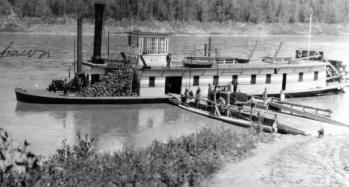
A reliable form of transportation was required to haul supplies and trade goods into the fur trade regions and return with large quantities of furs. The beginning of prairie settlement also required an efficient transportation system: one trip of a steamboat in a few days could eliminate a four-month trip for 400 Red River carts and their crews; the cost of shipping could be reduced by 50%. The Hudson’s Bay Company (HBC) explored the navigational potential of the Saskatchewan River by sending the International, a Red River steamboat, as far upstream as Carlton House in 1865. The company’s goal was to use steamboats to reorganize its transportation system along the 940-mile waterway from Fort Edmonton to the mouth of the Saskatchewan River at Grand Rapids, near Lake Winnipeg. Steamboats were being used to connect Winnipeg with the American railroads to the south, and through Lake Winnipeg to the Saskatchewan River in the north.
The first steamboat for the Saskatchewan River route was built above Grand Rapids in 1873; it was rushed into service, but wrecked on its first trip. The Northcote, built in 1874 to specifications similar to boats on the upper Mississippi and Missouri Rivers, made a successful voyage to Fort Carlton in late summer. It was the first of several steamboats that would navigate the treacherous Saskatchewan river waters that presented a number of natural obstacles to regular shipping by steamboat. These challenges included the low water levels, particularly in late summer; rocks and rapids; and shifting river channels. In 1877 the Lily started operations. By 1882 the new steamboats North West and Marquis were brought into service; that same year the Saskatchewan River broke its channel near Cumberland Lake, creating a marsh that lowered the river level and reduced the effective shipping season.
The Northcote and other steamers were used to carry troops and tow barges of supplies to Batoche during the North-West Resistance in 1885. The Northcote was seriously damaged when the Métis lowered a ferry cable that tore off the wheelhouse. After the battle the repaired Northcote was used to ferry the wounded to hospital in Saskatoon. As a prisoner, Louis Riel was transferred part of the way to trial in Regina by steamship. At first the HBC used the ships for their own transport, but later they established shipping companies that provided general freight and passenger services. There were a number of accidents and shipwrecks, but the main problem was the uncertainty of schedules and the high costs of transporting shipments stranded by low water. The last of the steamers, the North West, stopped service in 1896.
A number of companies used steamboats along parts of the Saskatchewan River where water conditions allowed more regular service. Local ferries were used for freight and passenger service. The Pas Lumber Company used steamboats to pull logs up the Carrot River to sawmills until 1954. William Pearson used two smaller steamboats on Last Mountain Lake from 1905 until 1913 for passenger and excursion service—but mainly as a method to encourage Americans to purchase land from his extensive holdings in the area. Finally the extension of rail service made the steamboat obsolete.
Bob Ivanochko